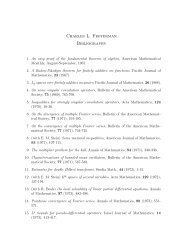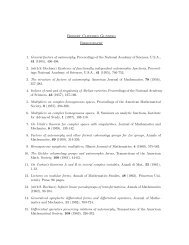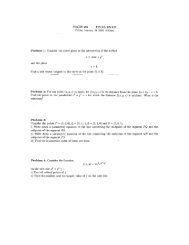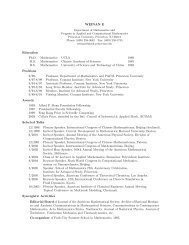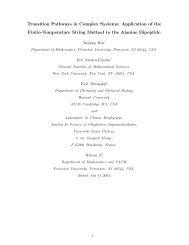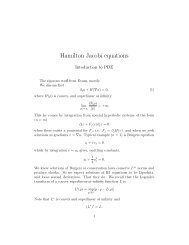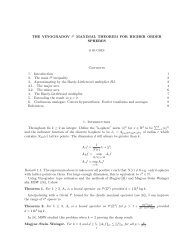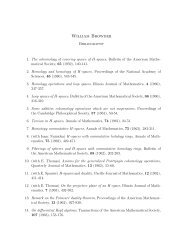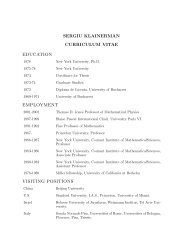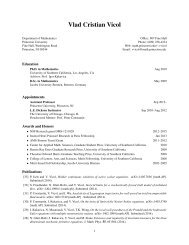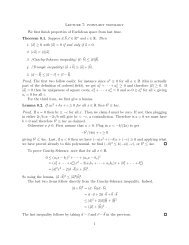The rational Khovanov homology of 3-strand pretzel links
The rational Khovanov homology of 3-strand pretzel links
The rational Khovanov homology of 3-strand pretzel links
Create successful ePaper yourself
Turn your PDF publications into a flip-book with our unique Google optimized e-Paper software.
THE RATIONAL KHOVANOV HOMOLOGY OF 3-STRAND PRETZEL LINKS 29<br />
But we must have dimX l+n−1,3l+3n−1 = dimX l+n−2,3l+3n−5 since X has no exceptional<br />
pair in t = l + n − 1 or t = l + n − 2. So both e 2 and e 3 must cancel.<br />
Finally, if e 4 did not cancel, then we would have dimX l+n−1,3l+3n−3 = dimX l+n,3l+3n+1 +<br />
1. But we need dim X l+n−1,3l+3n−3 = dimX l+n,3l+3n+1 , again because the only exceptional<br />
pairs <strong>of</strong> X are in t = 0 and t = 2l. Hence e 4 must cancel, and we have proved<br />
our formula when n is odd and less than l.<br />
<strong>The</strong> next case for odd n is n = l + 1. <strong>The</strong> middle <strong>of</strong> Figure 12 is a reference here. A<br />
similar argument implies that e 2 , e 3 , and e 4 all cancel, and a quick check verifies that<br />
our results for the lower and upper summands <strong>of</strong> X agree with Definition 2.5(4) and<br />
Definition 2.6(7).<br />
If n is odd and n > l + 1, then the right side <strong>of</strong> Figure 12 depicts the situation. <strong>The</strong><br />
generator e 1 still cannot cancel. But logic very similar to before implies that e 4 and<br />
a one-dimensional subspace <strong>of</strong> (e 2 ,e 3 ) must cancel, since X has no exceptional pairs<br />
in t = l + n. Thus, the lower summand loses an exceptional pair (as predicted by<br />
Definition 2.5), and the upper summand turns an exceptional pair into a knight’s move.<br />
Finally, suppose n is even; luckily, this case is easier. First, if n < l, we want to<br />
show that only e 4 cancels (using the above notation). Again, e 1 cannot cancel. If<br />
some combination <strong>of</strong> e 2 and e 3 cancelled, then we would have dimX l+n−1,3l+3n−1 <<br />
dimX l+n−2,3l+3n−5 , an impossibility since X has no exceptional pairs in t = l + n − 2.<br />
So both e 2 and e 3 survive.<br />
Since n < l, P(−l,l,n) is quasi-alternating by [4], so X l+n,3l+3n−3 = 0 for δ-grading<br />
reasons, and e 4 has nowhere to live. <strong>The</strong> cancellation is responsible for the next (−1)<br />
in the sequence d (n) , and e 2 and e 3 are responsible for the (2) following it.<br />
On the other hand, if n > l, then X has two exceptional pairs in t = l + n but<br />
V l+n = 0, so none <strong>of</strong> the e i can cancel. If n = l, the same argument holds: X must<br />
have three exceptional pairs in t = l + n but dimV l+n is only two, so none <strong>of</strong> the e i can<br />
cancel. Thus e 1 and (say) e 2 add an exceptional pair to the lower summand, and e 3 and<br />
e 4 add an exceptional pair to the upper summand. <strong>The</strong>se additions are precisely what<br />
we were expecting, completing the inductive argument.<br />
□<br />
5.2. P(−l,l + 1,n) for even l. Now we will make a similar computation for P(−l,l +<br />
1,n) which we will use as the base case in the induction to follow. As with odd l, we<br />
do not need to start with n = 0. We can use n = l instead; since P(−l,l + 1,l) =<br />
P(−l,l,l + 1), the previous section tells us the formula for Kh(P(−l,l + 1,l)).<br />
Lemma 5.2. For n ≥ l+1, Kh(P(−l,l+1,n)) is given by the formula in <strong>The</strong>orem 2.9.<br />
Pro<strong>of</strong>. Resolve the top crossing on the rightmost <strong>strand</strong>, a positive crossing. Our diagram<br />
for P(−l,l + 1,n) has no negative crossings, while the unoriented resolution (a<br />
diagram for the unknot) has l + n − 1 negative crossings. <strong>The</strong> oriented resolution is a<br />
diagram for P(−l,l + 1,n − 1). Hence the skein sequence is<br />
f<br />
q 3l+3n−1 t l+n Kh(U) Kh(P(−l,l + 1,n)) qKh(P(−l,l + 1,n − 1))<br />
f<br />
,




